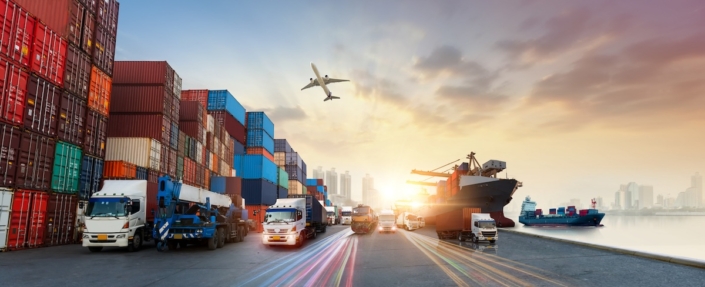First celebrated in 1970, Earth Day is a time to learn more about protecting the natural environment, both personally and as part of wider communities. This Earth Day, we’re sharing three sustainable logistics tips to help your business minimize its carbon footprint and keep the planet healthy.
1. Use sustainable last-mile delivery solutions
Last-mile delivery produces a significant portion of the supply chain’s carbon emissions. By investing in eco-friendly last-mile delivery options, you’ll lower emissions, reduce traffic congestion, and minimize your overall environmental impact.
The following solutions can make last-mile delivery more sustainable:
- Electric or hybrid vehicles. As you choose shipping carriers, consider partnering with those that include electric vehicles (EVs) in their fleets. Major carriers have already made strides in this area. For example, FedEx plans to convert their entire fleet to EVs by 2040, UPS states that their fleet includes over 1,000 EVs and hybrid vehicles, and USPS plans to have over 66,000 EVs in its fleet by 2028.
- Drone delivery. Large brands like Walmart have already begun experimenting with drone delivery. And it’s easy to understand why; in addition to decreasing carbon emissions, drones speed up delivery and lower costs. A 2023 study shows that drone deliveries reduce carbon emissions by 24.9%, cost by 22.13%, and delivery time by 20.65% compared to truck deliveries.
2. Power distribution centers with renewable energy (and lower energy consumption)
While last-mile delivery poses the most sustainability concerns, it’s also worth taking a look at other elements of your supply chain. Are you using energy as efficiently as possible in your warehouses and distribution centers?
Let’s look at two ways to make your logistics facilities more sustainable.
Solar panels
Transitioning to renewable energy sources, such as solar panels, can significantly reduce the carbon footprint of your fulfillment operations.
Warehouse and distribution center roofs are perfect candidates for solar panels: they’re large, flat, and receive plenty of sun. According to a report by Environment America, U.S. warehouses built before 2019 could generate 185.6 terawatt-hours (TWh) of solar electricity per year. This would reduce CO2 by 112 million metric tons—the equivalent of removing 24 million gas-powered cars from the roads.
The report states that many warehouses with solar panels can produce even more energy than they consume, and businesses can provide the excess energy to their local communities.
Reduce your distribution center’s footprint
Of course, solar panels are a major investment, especially for smaller businesses. A less expensive sustainability measure is reducing the footprint of your logistics facilities.
Kim Baudry from Dematic explains that bringing automation into the warehouse enables businesses to use their vertical space more effectively. And by shrinking your building’s footprint, you can save energy.
“I’ve walked into distribution centers where all of the racking is [only] halfway up the height of the building. The rest is open air, and it’s a lot of energy to cool, heat, or just maintain the temperature.”
“If you use the vertical space of your building, you’re actually more energy-efficient. For instance, you don’t have to have lights on inside of an automatic storage and retrieval system. They can be dark, and the space that you’re lighting is where the person is working.”
3. Handle returned products responsibly
Because returned items often meet their fate in a landfill, they can contribute to environmental degradation. Your business should focus on minimizing returns and keeping returned products out of landfills when possible.
Minimize returns
First things first: take action to decrease the number of products customers send back to you. You might combine several of the strategies below.
- Make product descriptions as detailed as possible.
- For clothes and accessories, provide accurate sizing information and virtual try-ons.
- Ensure accuracy during the order fulfillment process.
- Package products securely to avoid damage.
- Implement a 30-day return window.
- Consider charging for return shipping.
Note: Remember, the returns process plays an important role in the customer experience. If customers request returns for a valid reason, make the process as easy as possible for them to retain their loyalty.
Resell, recycle, or donate returned items
While some returned products may need to be disposed of, others can be refurbished, restocked immediately, recycled, or donated.
- Restock and sell. After inspecting returned items and making sure they’re still in perfect condition, return them to inventory and resell to other customers.
- Refurbish and sell. If an item has minimal damage, repair or restore it before reselling it.
- Donate. Offer the returned item to charitable organizations or community groups.
- Recycle the parts. Disassemble the returned item to salvage usable components or materials to recycle.
Find more sustainability ideas on the EasyPost blog
This article just covers three tips for greener logistics, but you have many other opportunities to decrease your business’s environmental impact. Consider the following ideas:
- Source materials sustainably
- Use eco-friendly tech
- Invest in sustainable packaging
- Minimize packaging materials
- Opt for ground shipping when possible
Interested in exploring these suggestions more? Check out our article 7 Best Practices for Sustainable Shipping.




